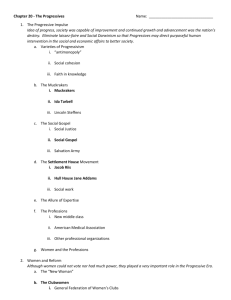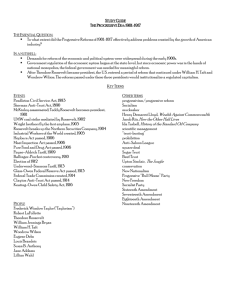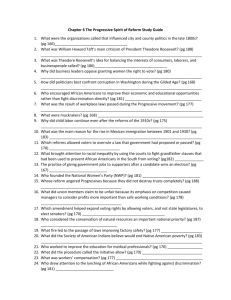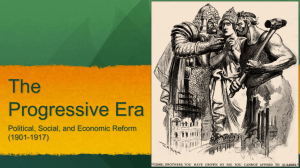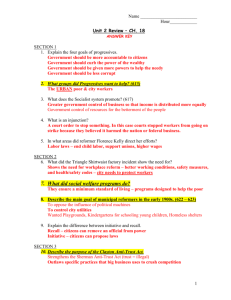Progressivism and Reform
advertisement
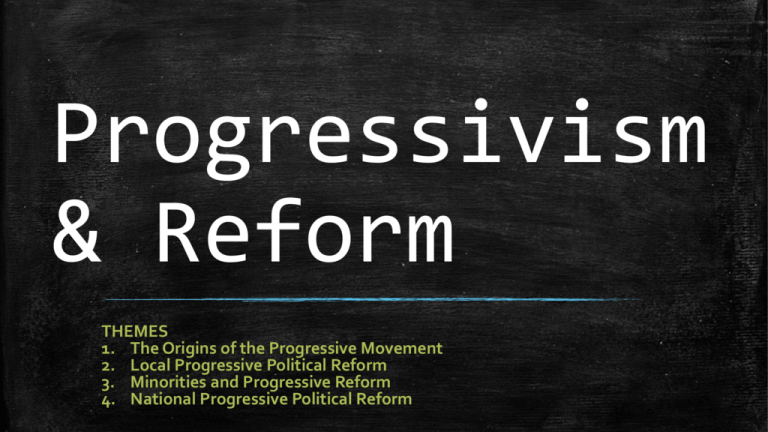
Progressivism & Reform THEMES 1. The Origins of the Progressive Movement 2. Local Progressive Political Reform 3. Minorities and Progressive Reform 4. National Progressive Political Reform Theme 1: The Origins of the Progressive Movement What is Progressivism? Progressives… 1. Believed in progress…Duh! 2. Are “Anti-monopoly”—fear of concentrated power and desire to limit and disperse wealth and power. 3. Want Social Cohesion—needs of the many outweigh the needs of the few or the one. 4. Scientific Managment—science, urbanization, planning, making the government more efficient will help society. 5. Want government to play a positive and important role in the process of improving and regulating society. Theme 1: The Origins of the Progressive Movement Who were the Progressives? ▪ People who wanted societal changes through the action of government ▪ Progressives were … – Protestant church leaders – Union leaders – Urban middle class/Professional class (doctors, lawyers, business people) ▪ Most Progressives considered themselves PRAGMATISTS— people who take a practical approach to life, their decisions and the actions of industry and the government. – Their conclusion using pragmatic thinking was…if its better for me…then it must be better for everyone, and if its better for them…it must be better for me. Theme 1: The Origins of the Progressive Movement Who Started/Fueled the Progressive Movement? The Muckrakers ▪ Journalists who directed public attention towards social, economic, and political injustices. ▪ First investigative journalists. ▪ Move away from Yellow Journalism in their search for the truth. ▪ Urged people to take a role in government and public life. ▪ Created the popular progressive movement. ▪ Took a pragmatic approach to reporting— tell the story as it is to make people want to reform Theme 2: Local Progressive Political Reforms Voter Participation ▪ Progressives believed that if more people could honestly participate in the election process at the local level, honest officials would win elections and power would be taken away from political bosses. ▪ They reformed the election process locally by… – SECRET BALLOTS—now voters could cast their vote privately in a booth without being watched by party officials – DIRECT PRIMARIES—Governor Robert La Follette of the great cheesy state of Wisconsin changed the way candidates were chosen taking it away from party conventions and giving it to the voters through primary elections – DIRECT ELECTIONS OF US SENEATOR—17th Amendment required all Senators to be elected by popular vote not by state legislatures. – REFERENDUM AND RECALL—Referendums allowed voters to vote on a particular law and recall votes allowed voters to vote to fire a politician Theme 2: Local Progressive Political Reforms Total Recall (HA! Get it!!!!) Theme 2: Local Progressive Political Reforms City Reform ▪ Since most Progressives lived is cities, much of the movement focused around fixing the problems of urban life ▪ PUBLIC CONTROL OF UTILITIES —reformers pushed for laws that required public utilities to be controlled and owned by the government to prevent price gauging and miss-management ▪ CITY MANAGERS —To combat the spoils system in local politics, reformers called for all city officials to be elected (police/fire commissioners, city planners, sanitation, etc.) Sorry Flint Theme 2: Local Progressive Political Reforms State Reform The Settlement House Movement ▪ The Hull House—opened in 1889 by Jane Addams in Chicago – – – – – – – – Became a model for the urban poor Community center for poor urban immigrants Staffed by socially conscious middle class women Mission: to educate and incorporate immigrants into American life. Goal was to create more “middle class people” Many college women got their start in Hull Housing Created the profession of Social Work This began government involvement in SOCIAL WELFARE— government expenditures to help the poor Theme 2: Local Progressive Political Reforms The Crusades ▪ THE TEMPERACE CRUSADE—led by Protestant women who felt that alcohol was a root of evil – Partly motivated by anti-Catholic sentiment – Wanted alcohol to be illegal – Led to Prohibition ▪ WOMENS SUFFRAGE—started at the state level – Women, who played a big roll in welfare projects wanted a roll in government too ▪ CIVIL RIGHTS—as more urban African American’s became educated, they became more demanding for social equality – Only a small fraction of the urban poor were African American Theme 2: Local Progressive Political Reforms Workplace and Labor Reform Progressives advocated for the urban/industrial laborer demanding: ▪ eight-hour work days ▪ improved safety & health conditions in factories ▪ workers compensation laws ▪ minimum wage laws ▪ unionization ▪ child labor laws ▪ Triangle Shirtwaste Fire “Breaker Boys” Pennsylvania, 1911 State Social Reform: Child Labor Child Laborers in Indiana Glass Works, Midnight, Indiana. 1908 Child Laborer, Newberry, S.C. 1908 Shrimp pickers in Peerless Oyster Co. Bay St. Louis, Miss., March 3, 1911 Theme 3 : Minorities and Progressive Reform WOMEN ▪ “women’s professions” ▪ “new woman” ▪ clubwomen A local club for nurses was formed in New York City in 1894. Here the club members are pictured in their clubhouse reception area. (Photo courtesy of the Women's History and Resource Center, General Federation of Women's Clubs.) The Women's Club of Madison, Wisconsin conducted classes in food, nutrition, and sewing for recent immigrants. (Photo courtesy of the Women's History and Resource Center, General Federation of Women's Clubs.) Theme 3 : Minorities and Progressive Reform Women’s Suffrage ▪ National American Woman Suffrage Association (NAWSA) ▪ Carrie Chapman Catt Ohio Woman Suffrage Headquarters, Cleveland, 1912 Woman suffrage before 1920 Theme 3: Minorities and Progressive Reform Women’s Suffrage ▪ National Woman’s Party ▪ Nineteenth Amendment ▪ Equal Rights Amendment Suffragette Banner 1918 19th Amendment National Woman’s Party members picketing in front of the White House, 1917 (All: Library of Congress) Black Population, 1920 Theme 3: Minorities and Progressive Reform African-Americans ▪ ▪ ▪ ▪ ▪ Booker T. Washington W.E.B. Du Bois Niagara Movement “talented tenth” NAACP W.E.B. Du Bois Booker T. Washington Theme 4: National Reform Assassination of President McKinley, Sept 6, 1901 Theme 4: National Reform Theodore Roosevelt: “accidental President” Republican (1901-1909) (The New-York Historical Society) the Theme 4: National Reform Roosevelt’s “Square Deal” ▪ 1902 Anthracite Coal Miners Strike ▪ “Square Deal”—Roosevelt’s philosophy to give an even deal in negotiations between Labor and Business Anthracite miners at Scranton, Pennsylvania, 1900 Theme 4: National Reform Roosevelt the “trust-buster” ▪ Northern Securities Company (1904) ▪ “good trusts” and “bad trusts” ▪ Hepburn Railroad Regulation Act (1906)—Roosevelt’s law that allowed the government to regulate railroad fares “ONE SEES HIS FINISH UNLESS GOOD GOVERNMENT RETAKES THE SHIP” Theme 4: National Reform The Birth of REGULATORY COMMISSIONS and Consumer protections ▪ Muckrakers and progressive reformers demanded the government create REGULARTORY COMMISSIONS that oversaw and enforced safe working conditions and food production in factories ▪ Upton Sinclair’s The Jungle about the meatpacking plants in Chicago led to: – Pure Food and Drug Act (1906) – Meat Inspection Act (1906) Theme 4: National Reform Roosevelt & Conservation ▪ Used the Forest Reserve Act of 1891 ▪ U.S. Forest Service (1906) ▪ Gifford Pinchot ▪ White House conference on conservation 1908 ▪ John Muir— naturalist who befriended Roosevelt and pushed for conservation Theodore Roosevelt & John Muir at Yosemite 1906 Theodore Roosevelt and Gifford Pinchot, 1907 CONSERVATION: National Parks and Forests William Howard Taft President 1909-13 Republican Postcard with Taft cartoon Taft’s Progressive Accomplishments ▪ TRUST-BUSTING –more trusts busted than Roosevelt ▪ forest and oil reserves ▪ SIXTEENTH AMENDMENT— Senate elected by direct election Why me? BUT: CAUSED SPLIT IN REPUBLICAN PARTY – Payne-Aldrich Tariff (1909) –Republican congress broke Taft’s campaign promise to lower the tariff then publically supported it angering progressives. – Pinchot-Ballinger Controversy— a debate between members of Taft’s cabinet (one a conservative and the other progressive) forced Taft to take sides…he sided with the conservative Ballinger and fired Pinchot further angering progressives Theme 4: National Reform Taft and Dollar Diplomacy ▪ Taft believed that the best way to expand American influence was to encourage American Business to expand their source of resources and their markets to foreign lands…this was called DOLLAR DIPLOMACY ▪ Taft used Dollar Diplomacy in China by inviting American railroad tycoons to meet with Chinese officials and offer their services in building railroads in China Theme 4: National Reform Election of 1912 ▪ Woodrow Wilson ▪ Progressive Party (“Bull Moose party”) ▪ “New Nationalism” Third and Fourth Parties—Progressives and Socialists ▪ Socialist Eugene V. Debs enters the race as a new party ▪ Socialists—were a pure labor party who advocated for more radical progressive reforms – Like having the government own the railroads, Woodrow Wilson Theodore Roosevelt cartoon, March 1912 1912 Presidential Election Theme 4: National Reform Woodrow Wilson ▪ “New Freedom” ▪ Underwood Simmons Tariff (1913) ▪ Sixteenth Amendment (1913) ▪ Federal Reserve Act (1913) ▪ Federal Trade Commission Act (1914) ▪ Clayton Anti-Trust Act (1914)—helped the government break up monopolies and trusts and provided specific language NOT allowing unions to be considered trusts ▪ Keating-Owen Act (1916) Wilson at the peak of his power Theme 4: National Reform Federal Reserve Act—Federal Reserve System

